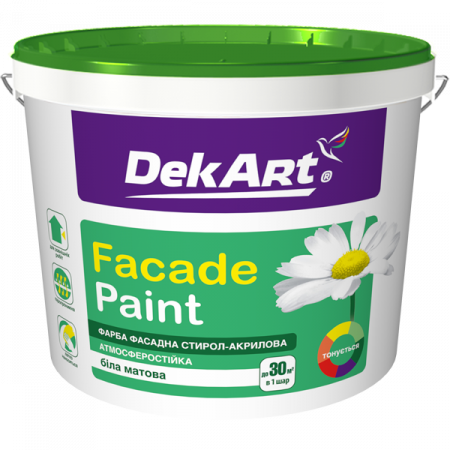
DekArt
Faсade Paint
Краска фасадная
Specification
Facade paint creates hard, durable matt coating, which is resistant to weather effects with high vapor permeability (acc. to DSTU EN 1062). The product is applied easily and doesn't splash while applying.
Sphere of application
The paint is intended for coating of the building facades, that made of any mineral material (stucco, plaster, brick, concrete, slag block), and also gypsum and wooden bases.
It is recommended for the coating of living, public, administrative, commercial, storing buildings and industrial companies facades.
Tinting
It can be tinted manually with Pigment Concentrate Farbex Color, other waterborne coloring pastes or with a coloring machine acc. to NCS color range and others.
Content
Technical data
| Consumption standard of 1 layer | 130-180 g/m2. It depends on the way of application and type of surface. |
| Thinner | Water. Maximal allowed delution is 10% of the total weight. |
| Application | Apply with a roller, a brush or a spraying gun. |
| Drying period (23 °С, 50% RH) | max. 1 hour. Drying period increases if the temperature is getting down and relative air humidity is getting higher. |
| Solids content (DSTU ISO 3251) | 64±2 % |
| Density (DSTU ISO 2811-1) | ≈ 1,62 g/cm3 |
| Gloss (DSTU ISO 2813) | Max. 5 GU at 85° (matt, G3, DSTU EN 1062-1) |
| Dry film thickness | 50-100 microns, for a single coat (E2, DSTU EN 1062-1) |
| Particle size | max. 30 microns, (fine-grained, S1, DSTU EN 1062-1) |
| Vapor permeability (EN ISO 7783-2) | max. 300 g(m2*day) , (high, V1, DSTU EN 1062-1) |
| Water permeability (DSTU EN 1062-3) | max. 1,5 kg/(m2*h0,5) , (high, W1, DSTU EN 1062-1) |
| Marking acc. to the DSTU EN 1062-1 | G3|E2|S1|V1|W1|A0|C0 |
| VOC content (ISO 11890) | - |
| Warranty period | 18 months from the date of manufacturing |
| Packaging | 1,2 kg, 4 kg, 6,3 kg, 12,6 kg, 20 kg |
Gloss
Color
Application instruction
-
1. Preliminary preparation
Uncoated surface: Clean it from loose coatings, dust, oil, grease and other dirt.
Previously coated surfaces: Clean thoroughly the surface from old loose coatings (loose paint and varnish) in mechanical (a scraper, a wire brush), thermal (hot air fan, infrared radiation) or chemical way (paint removal solutions). Chalk and lime-chalk coatings shall be removed mechanically till hard surface. Clean the surface also from other dirt. Surfaces, previously coated with alkyd and oil enamel, shall be sandpapered. Then treat it as uncoated surface.
Small defects of mineral surface shall be corrected with finishing putty TM Farbex and sandpaper after that.
For protection against mould and fungi it is recommended to treat the surface with antiseptic TM Farbex.
2. Priming
Previously treated mineral and wooden surfaces need no undercoating.
Previously untreated absorbing mineral surfaces shall be undercoated with Deep-penetrating primer "Base" TM DekArt for better adhesion and to make absorbing capacity of the surface uniform.
Previously untreated wooden surfaces shall be undercoated with Acrylic wood primer ТМ Maxima.
3. Application
Stir the paint thoroughly before application. If it is required dilute it with water. Over-dilution makes the quality of the surface worse! Application is performed at the temperature from + 5 °С till + 35 °С and relative air humidity no more than 80%. Apply the paint in 1-2 coats with a brush, a roller, or a spraying gun.
Do not apply under direct sunlight, strong wind, frost and atmospheric precipitation. After the coating is applied it shall not be affected by atmospheric precipitation and sub-zero temperatures before finishing coating for 8 hours.
4. Tool cleaning
Clean tools with water after application. Do not let them dry. Dry product shall be removed from the tools in mechanical way.
References

Фасад Детской областной консультативной поликлиники окрашены фасадной краской Faсade Paint DekArt.
Flow calculator
Consumption standard of 1 layer
When calculating the area to be painted, you need to subtract the area that will not be painted. (windows, doors, etc.)
Paint consumption may vary depending on dilution and uniformity of application of the paint.